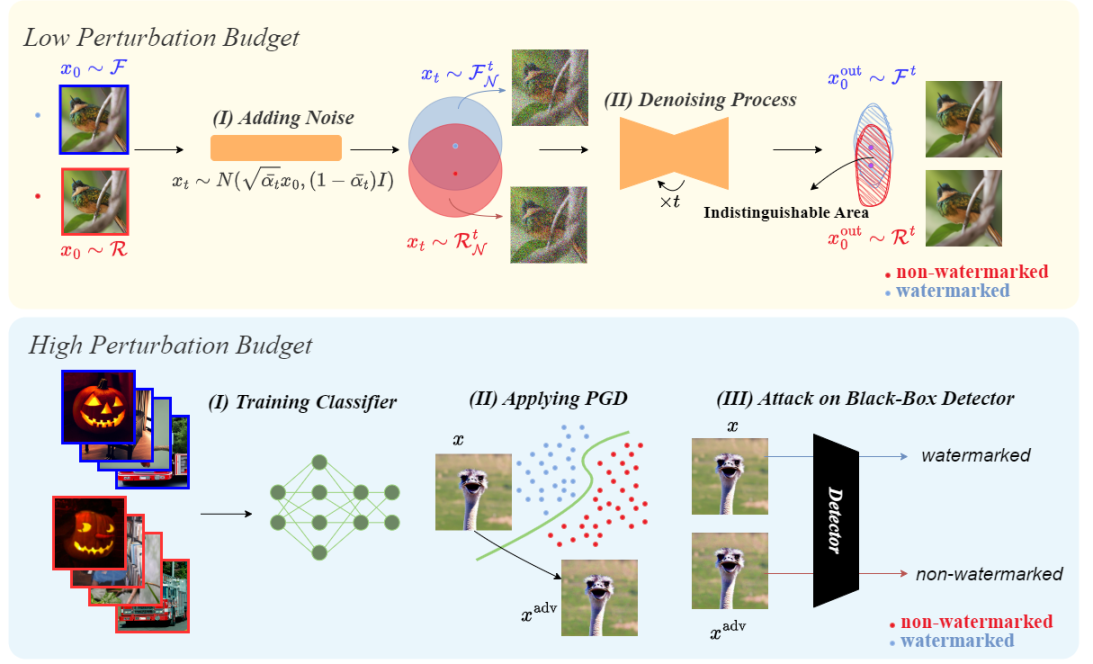Robustness of AI-Image Detectors: Fundamental Limits and Practical Attacks
Mehrdad Saberi, Vinu Sankar Sadasivan, Keivan Rezaei, Aounon Kumar, Atoosa Chegini, Wenxiao Wang, Soheil Feizi
ICLR 2024
This repository includes the implementation of several types of attacks against image watermarking methods, which were proposed in the article "Robustness of AI-Image Detectors: Fundamental Limits and Practical Attacks". The image watermarking methods are unified in the code in a way that it's easy to apply them to images and evaluate them on various attacks.
- Diffusion Purification
- Model Substitution Adversarial Attack (against TreeRing and StegaStamp watermarks)
- Spoofing Attack
- Common Perturbations
- Image Editing (limited implementation)
Install the requirements with pip install -r requirements.txt.
If there are problems with the dependancies, you can refer to the requirements_full.txt file for the complete list of libraries.
Run _bash_download_models.sh to download pretrained models that are used in the code.
In this part, the procedure to apply watermarking methods to images, and evaluting them against diffusion purification attack is explained. Evaluation against common perturbation and image editing is done in a similar way.
Specify path to imagenet dataset in _bash_generate_seed_data.sh, and run the script to store images for further usage.
Uncomment the intended parts of the script from _bash_apply_wm.sh, and run it, to apply different types of watermarks on the seed data.
The code from evaluate_watermark.py can be used to evaluate watermarked images against various attacks. The type of attack used for the evaluation can be specified with the --attack argument. An example of how to run this code for diffusion purification is given in the _bash_eval_wm.sh file.
Afterwards, the detailed scores and the ROC curves for the evaluation will be available in the results folder.
Adversarial attacks are performed for the high-perturbation watermarks (refer to the paper), which are TreeRing and StegaStamp.
The binary classifiers are trained to distinguish between the watermarked images (w.r.t. some watermarking method) and non-watermarked images. You can either train these classifiers or use the classifier weights that will be downloaded to the checkpoints/classifiers folder if the _bash_download_models.sh script is ran.
In order to train classifiers yourself, you must follow these steps:
- Use the part of
_bash_generate_seed_data.shthat is for generating non-watermarked data classifier training. - Use the part at the end of
_bash_apply_wm.shto generate watermarked training data for your intended watermarking method. - Train the classifier using the
_bash_train_classifier.shscript.
Run the script from _bash_adv_attack.sh to apply adversarial attack to the watermarked and non-watermarked images, using the loss function of the trained classifier.
By giving the path to the folder where the adversarial examples are stored, as arguments to the code in evaluate_watermark.py, you can view the detailed scores and the ROC curves that show the robustness of the watermarking methods against the adversarial attack. An example of this evaluation for eps=12 is given at the bottom part of the _bash_eval_wm.sh script.
Implementation of the spoofing attack proposed in the paper is available in the spoof_watermark folder. Moreover, the code for some of the experiments on deepfake classifiers is avaiable in the deepfake folder.
@inproceedings{saberi2023robustness,
title={Robustness of AI-Image Detectors: Fundamental Limits and Practical Attacks},
author={Saberi, Mehrdad and Sadasivan, Vinu Sankar and Rezaei, Keivan and Kumar, Aounon and Chegini, Atoosa and Wang, Wenxiao and Feizi, Soheil},
booktitle = {ICLR},
year = {2024}
}
